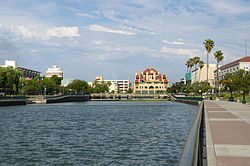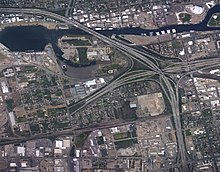| Stockton Channel - McLeod lake | |
|---|---|
 Stockton Channel at Downtown Stockton's waterfront, June 2013 | |
 | |
| Location | |
| Country | United States |
| State | California |
| Physical characteristics | |
| Source | |
| • location | San Joaquin River |
| • elevation | 13 ft (4.0 m) |
| Mouth | |
• location | |
• coordinates | 37°57′11″N 121°19′12″W / 37.953°N 121.32°W |
| Length | 2.5 mi (4.0 km) |
| Width | |
| • minimum | 200 ft (61 m) |
| • maximum | 380 ft (120 m) |
| Depth | |
| • minimum | 9 ft (2.7 m) |
| • maximum | 35 ft (11 m) |
| Basin features | |
| River system | Sacramento–San Joaquin Delta |
| Bridges | Interstate 5 |
| Inland ports |
|







Stockton Channel (or Stockton Waterfront) is a waterway in California's Sacramento–San Joaquin River Delta. It runs 2.5 miles from the San Joaquin River-Stockton Deepwater Shipping Channel at the Port of Stockton to McLeod Lake in Downtown Stockton. The Stockton Channel is contained by levees, with Miners Levee is on the north side and Tuleburg Levee on the south side. The Mormon Slough branches off the Stockton Channel to the Southeast. The Smith Channel runs parallel to the north of the Stockton Channel. Interstate 5 crosses the Channel at its midpoint.[1][2][3][4][5][6]
The Stockton Channel overflowed its banks in the great flood of 1955. San Joaquin County was named a federal disaster area. The 1955 flood remained the largest San Joaquin County flood on record until 1997.[7][8]
United States Army Corps of Engineers performs annual maintenance on the Stockton Channel, which includes dredging to remove silt.[9] A dam on Mormon Slough was built to stop flooding and slit build up in the Stockton Channel. The Dam was removed on 24 October 2016.[10]
McLeod Lake is named after Alexander Roderick McLeod who came to Stockton from Hudson Bay to trap beaver.[11][12][13]
- ^ Engineering Record, Building Record and Sanitary Engineer, Volume 61, page 782, by Edward J. Mehren, Henry Coddington Meyer, John M. Goodell, June 1910
- ^ Stockton Marina
- ^ City of Stockton, History, Miner Channel Historic Block A New Site Discovered
- ^ KCRA, Upgrades coming to I-5 bridge in Stockton, Jun 1, 2018
- ^ City of Stockton, History
- ^ Port of Stockton, about
- ^ Fitzgerald, Michael (November 6, 2005). "1955 flood a disaster for S.J." The Record. Stockton, CA. Retrieved August 26, 2021.
- ^ Breitler, Alex (January 5, 2017). "Flooding: It's happened before". The Record. Stockton, CA. Retrieved August 26, 2021.
- ^ Feinstein, senate.gov Bugest , May 22 2009
- ^ Stockton East Water District , 2016 Dam Removal Schedule
- ^ biographi.ca, Alexander Roderick McLeod
- ^ Remembering Stockton history, J. Frederick Loeber (1840-1906)
- ^ The San Joaquin: A River Betrayed, By Gene Rose, page 22